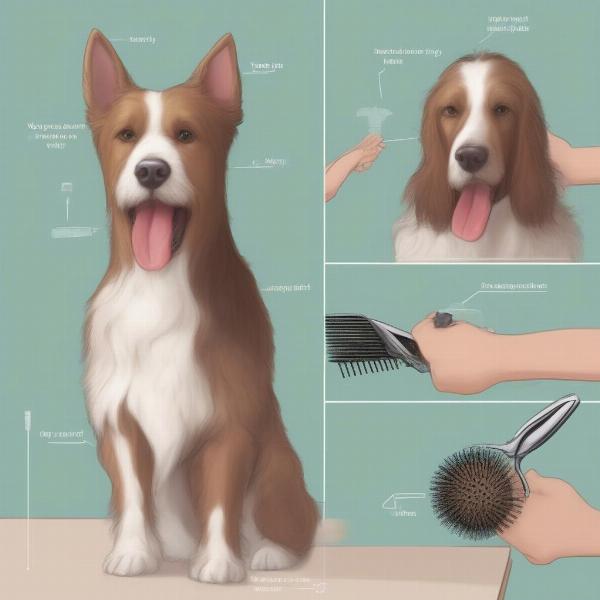Dog hair combs are an essential tool for any dog owner. Whether you’re dealing with mats, tangles, shedding, or just want to keep your dog’s coat looking its best, a good dog hair comb can make all the difference. This guide will cover everything you need to know about dog hair combs, from choosing the right type to proper combing techniques.
Types of Dog Hair Combs
There are a variety of dog hair combs available, each designed for a specific purpose. Understanding these differences will help you choose the perfect comb for your dog’s coat type and grooming needs.
Dematting Combs
Dematting combs are specifically designed to remove mats and tangles. They typically have sharp teeth that can cut through tough knots. However, use these with caution to avoid hurting your dog.
Undercoat Rakes
These combs are ideal for dogs with thick undercoats, like Huskies or German Shepherds. They help remove loose fur and prevent matting, especially during shedding season.
Flea Combs
Flea combs have very fine teeth that are close together, designed to catch fleas and their eggs. They’re useful for detecting and removing fleas, even if your dog isn’t showing obvious signs of infestation.
Double-Sided Combs
These versatile combs have two sides – one with wider teeth for general grooming and the other with finer teeth for removing tangles and debris.
Choosing the Right Comb for Your Dog
The right comb for your dog depends on their breed, coat type, and grooming needs. Short-haired breeds might only need a basic comb, while long-haired breeds require more specialized tools.
Short-Haired Dogs
For short-haired dogs, a rubber curry brush or a comb with fine teeth can be sufficient for removing loose hair and stimulating the skin.
Long-Haired Dogs
Long-haired dogs benefit from a combination of combs, including a slicker brush, an undercoat rake (if they have a double coat), and a wide-toothed comb for detangling.
Dogs with Thick Undercoats
Dogs with thick undercoats require regular grooming with an undercoat rake to prevent matting and excessive shedding.
How to Use a Dog Hair Comb
Proper combing technique is essential to avoid hurting your dog and achieve the best results.
- Start Gently: Always begin with a wide-toothed comb and work your way down to finer teeth.
- Work in Sections: Divide your dog’s coat into sections and work on one area at a time.
- Be Patient: If you encounter a mat, gently tease it apart with your fingers or a dematting tool before using the comb. Never pull or yank.
- Reward Your Dog: Make the experience positive by offering treats and praise.
 Proper Dog Hair Combing Technique
Proper Dog Hair Combing Technique
Benefits of Regular Combing
Regular combing provides several benefits for your dog’s health and well-being:
- Reduces Shedding: Regular combing removes loose fur, minimizing the amount of hair around your house.
- Prevents Mats and Tangles: Combing helps prevent mats and tangles, which can be painful and lead to skin infections. how to help dry skin in dogs
- Improves Coat Health: Combing distributes natural oils throughout the coat, keeping it healthy and shiny. tropical dog shampoo
- Early Detection of Skin Issues: Combing allows you to detect any skin problems, such as parasites or irritation, early on. pictures of harvest mites on dogs
- Bonding Experience: Combing can be a relaxing and enjoyable bonding experience for you and your dog. dog and teepee
Conclusion
Choosing the right dog hair comb and using it correctly are crucial aspects of dog ownership. chain leashes for dogs Regular combing helps maintain your dog’s coat health, prevents matting, reduces shedding, and strengthens the bond between you and your furry friend.
FAQ
- How often should I comb my dog? The frequency depends on your dog’s breed and coat type. Long-haired dogs may need daily combing, while short-haired dogs might only need it weekly.
- Can I use a human hair comb on my dog? It’s best to use combs specifically designed for dogs, as human combs can damage their coat.
- What should I do if my dog has a mat I can’t remove? Consult a professional groomer. They have the tools and expertise to safely remove stubborn mats.
- How can I make combing more enjoyable for my dog? Start slowly, use positive reinforcement, and make it a relaxing experience.
- What are the signs of a skin problem while combing? Look for redness, irritation, excessive scratching, or unusual bumps or lumps.
- Are there different comb sizes for different dog sizes? Yes, combs come in different sizes to accommodate dogs of all breeds and sizes.
- How do I clean a dog hair comb? Wash the comb with warm soapy water and dry it thoroughly after each use.
ILM Dog is your one-stop resource for expert advice on all aspects of dog care and breeding. We offer comprehensive information on dog breeds, health, training, nutrition, grooming, and much more. Whether you’re a seasoned dog owner or just starting out, ILM Dog provides valuable insights to help you provide the best possible care for your canine companion. Contact us today for expert advice and personalized support! Email: [email protected]. Phone: +44 20-3965-8624.